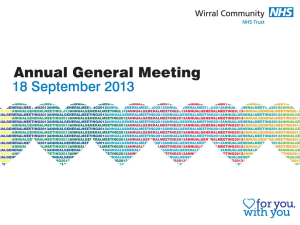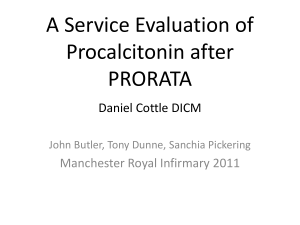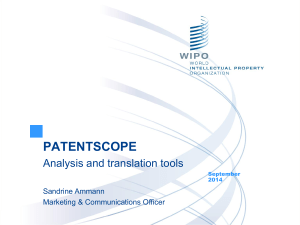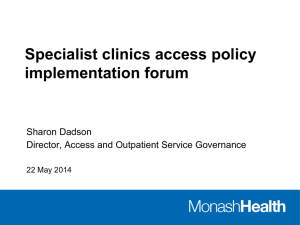individual funding requests – the rugby experience
advertisement
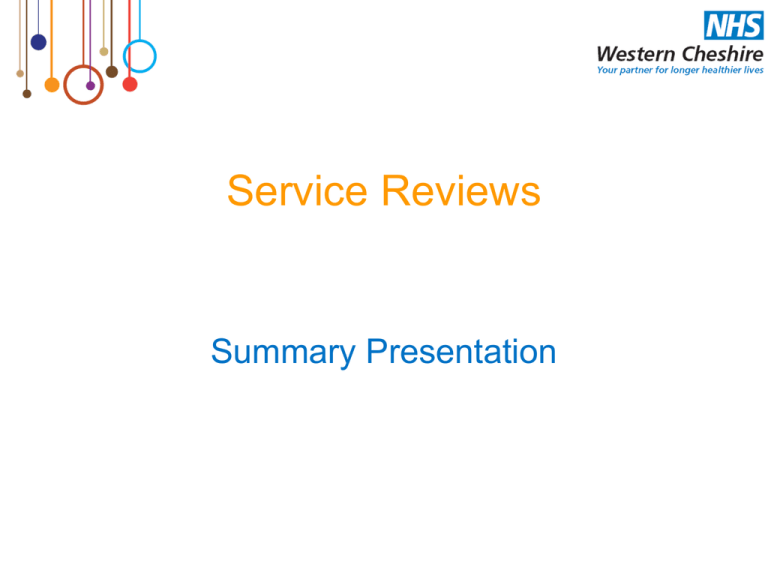
Service Reviews Summary Presentation Background • • • Part of the £15million of savings for 2010/11. We will have to disinvest in some health programmes and services to invest in others. This programme focuses on “allocative efficiency”: using our resources to produce the right quantity of each service. The “right quantity” must take into account the views of patients and the wider public. The programme will help us deliver one of the core requirements of a commissioning organisation; to understand what we spend our money on and what value we get from it. Methodology Three stage approach: 1. Understanding our current expenditure 2. Service reviews of identified areas / health programmes 3. Implementation of agreed recommendations from service reviews Understanding our Current Expenditure • We have analysed, by health programme, our expenditure using the most up to date comparative information. We invested £373million of the public’s money in 2008/09 • Programme budgeting information gives a greater understanding of where public money is being invested in the NHS and what value is obtained for the investment • The information maps all expenditure to 23 programmes of care based on medical conditions such as mental health, cardio vascular disease and cancer. Chart 1: Column Chart showing the variance of NHS Western Cheshire expenditure from cluster average for main programmes Programme budget analysis – spend & outcomes 6.0 4.0 • Insert quadrant?? Variance £million per 100,000 population 2.0 01 02 03 04 05 06 07 08 09 10 11 12 13 14 -2.0 -4.0 -6.0 -8.0 Programme Budgeting Category Source: Department of Health 2008-09 Programme Budgeting PCT Benchmarking Tool 15 16 17 18 19 20 21 22 23 Programme Budgeting Categories 1 Infectious diseases 2 Cancers and Tumours 3 Disorders of Blood 4 Endocrine, Nutritional and Metabolic problems 5 Mental Health Disorders 6 Problems of Learning Disability 7 Neurological 8 Problems of Vision 9 Problems of Hearing 10 Problems of circulation 11 Problems of the respiratory system 12 Dental Problems 13 Problems of The gastro intestinal system 14 Problems of the skin 15 Problems of the Musculo skeletal system 16 Problems due to Trauma and Injuries 17 Problems of Genito Urinary system 18 Maternity and Reproductive Health 19 Conditions of neonates 20 Adverse effects and poisoning 21 Healthy Individuals 22 Social Care Needs 23 Other Where we spend more than we should! • We have used this information to compare our expenditure with that of similar organisations (other prospering smaller towns). This shows that we spend more on: • Genito urinary system (£24.3m)- £2.7m more than similar PCTs • Musculo skeletal system (£26.5m)- £2.5m more than similar PCTs • Circulatory problems (£39.2m)- £3m more than similar PCTs Chart 2 Service reviews • Our intention is to systematically review all programmes over the next two years • Service reviews have been conducted using a four stage process: 1. Describe current services: cost, volume, efficiency and effectiveness 2. Define best practice: Rapid appraisal of what the best performing organisations are doing 3. Recommendations: Identifying proposed changes within the service to prevent illness increase quality, drive productivity or introduce innovation (QIPP!) 4. Implementation. Delivering the required commissioning changes Cardiology • • • • • • • Major burden of ill health in Western Cheshire so a proportionately higher spend in this area is expected and may be appropriate However, benchmarking information shows efficiency opportunities Primary prevention will play a key role in managing demand Comparative information suggests reduce the overall number of outpatient attendances. Introducing clear referral pathways for cardiology and educating GP practices about cardiology management and care pathways will reduce this variation. There are also opportunities to explore transferring outpatient care from the acute sector to primary and community care. The length of stay data suggests that service redesign can release savings through reduced length of stay and excess bed days in secondary care. NHS Western Cheshire benchmarks poorly in national efficiency indicators (better care better value) for prescribing of drugs relating to the management of cholesterol and heart failure. Recommendations • • • • • • • • • • Do more vascular health checks focusing on men within the most deprived areas. This would cost c. £120,000 as well as additional expenditure on prescribing but is estimated to save around £1.6m for NHS Western Cheshire. Continued focus on the identification of patients with hypertension (high blood pressure). This would cost c. £360k in primary care prescribing. Estimated savings of £1.37m in non-elective stroke admissions. Reduce outpatient attendances (estimated saving £185k): – Introduce referral thresholds for GPs – Commission a “telephone consultation clinic” for GPs to speak to consultant at agreed phone consultation tariff. – Establish a community-based service for cardiac patients Reduce outpatient attendances following an emergency admission by referring an agreed cohort back to primary care Estimated saving £65,184. Introduce a threshold for varicose vein treatment. Estimated saving £237,480. To improve Deep Vein Thrombosis (DVT) pathway (already at case outline stage). Estimated savings of £259,440 Reduce excess bed days through contract enforcement (i.e. not paying for lengths of stay beyond peer group of hospitals) Estimated saving £205,000 Increase the efficiency of statin prescribing Estimated savings £400,000. Increase the efficiency of heart failure prescribing. Estimated savings £180,000. Ensure benefit realisation from introduction of generic version of clopidogrel. Estimated savings £500,000 Out Patient 1st Attendance Following an Emergency Admission per 1000 Population Orthopaedics • • • • • Reduce outpatient attendances which increased last financial year Reduce follow up appointments following joint replacement. Determine whether the musculoskeletal assessment service adds any patient or administrative value to the pathway. Major inefficiency of our utilisation of the Independent Sector Treatment Centre at Halton. Although this contract is about to enter its final year it is essential that NHS Western Cheshire focuses its attention on achieving better value for money from this contract. Scope to reduce prescribing by about £50,000 in this programme area. Recommendations • Review musculo skeletal assessment service- best practice services manage 80% of referrals within a community service • Maximise the usage of the ISTC contract: Estimated savings of between £387k and £1.8m • Introduce more restrictive thresholds for carpal tunnel Syndrome surgery and other hand conditions: Estimated savings of £380,512 • Implement the glucosamine prescribing policy. Estimated savings £50k Variance Month Target Feb-10 Jan-10 Dec-09 Nov-09 Oct-09 Sep-09 Aug-09 Jul-09 Jun-09 May-09 Apr-09 Mar-09 Feb-09 Jan-09 Dec-08 Nov-08 Oct-08 Sep-08 Aug-08 Jul-08 Jun-08 May-08 Apr-08 Mar-08 Feb-08 Jan-08 Dec-07 Nov-07 Oct-07 Sep-07 Aug-07 Jul-07 Jun-07 Value ISCT - contract variance £150,000 £100,000 £50,000 £0 -£50,000 -£100,000 -£150,000 -£200,000 -£250,000 Rheumatology • Year on year increase in both first and follow up appointments • Benchmarking information shows that there are efficiencies to be made particularly in follow up outpatient appointments through both contractual levers and in the shift of service to primary care. This has already been piloted by practice based commissioners and is now recommended for full implementation. • There is also scope to administer intramuscular injections in primary care but this requires further work before a business case can be made for this change. Recommendations • Implement first to follow up ratio into contract with the Countess of Chester Hospital. Estimated net saving of £248,214 • Reduce number of reviews for stable chronic rheumatoid arthritis patients to once a year conducted at primary care rather than secondary care through the implementation of a Rheumatology Follow up service. Estimated net saving of £20,000. • Promote the administration of intramuscular injections in primary care. Financial impact to be quantified. • Localise Map of medicine pathways • Education of GPs and practice nursing staff • Improved self care management PCT Warrington PCT Western Cheshire PCT Central and Eastern Cheshire PCT East Riding of Yorkshire PCT Warwickshire PCT Central Lancashire PCT Worcestershire PCT Gloucestershire PCT Trafford PCT Bury PCT Eastern and Coastal Kent PCT Herefordshire PCT South Gloucestershire PCT North Somerset PCT South Staffordshire PCT Hampshire PCT Lincolnshire Teaching PCT Suffolk PCT West Sussex PCT South East Essex PCT North Yorkshire and York PCT Somerset PCT Wiltshire PCT Bedfordshire PCT Bath and North East Somerset PCT Shropshire County PCT Norfolk PCT North East Essex PCT Stockport PCT East Sussex Downs and Weald PCT Bournemouth and Poole Teaching PCT Northamptonshire Teaching PCT Leicestershire County and Rutland PCT Standardised Rate Rheumatology Outpatient Follow-up to First Attendance Ratio 08/09 7 6 5 4 3 PCTs within ONS Cluster National Average ONS Cluster Average 2 1 0 Arthritis Summary and Recommendations • Activity and cost information largely included within rheumatology. • Two specific recommendations are being made as a result of the review and analysis of best practice elsewhere in the country. • Introduce more restrictive thresholds for arthroscopic procedures for osteoarthritis of the Knee. Potential Cost Savings : £76,413 • Introduce more restrictive thresholds for surgery for Carpal Tunnel Syndrome and other hand conditions. Potential Cost Savings: £380,352 Osteoporosis • • • • Significant emphasis on prevention, targeting bone health and exercise as these have the strongest evidence base. Osteoporosis often only recognised after an older person falls and sustains a fragility fracture. NHS Western Cheshire has commissioned a fracture liaison service at the Countess of Chester Foundation Trust Hospital. Diagnosis needs to be confirmed by a DEXA scan. There is currently no local provider and GPs have to referrer out of area to a range of providers who charge from £50 to £134 a scan. Analysis shows that around 400 additional scans are required if NICE guidance was followed systematically. Oral medication of a group of drugs called is one of the main treatments for osteoporosis and the review has identified efficiency savings in primary care prescribing. Recommendations • Redesign the DEXA scanning pathway and procure a local service. Potential Cost Savings: £51,024 • Increase the clinically appropriate proportion of patients on alendronate: Potential Cost Savings: £85,000 (assumes 50% conversion rate) Urology – – – – – – Demand for urology services is increasing especially in the over 50s who make the heaviest demand upon urology care. Work is shifting away from surgery towards diagnostics and medical treatments There are a number of contractual opportunities including a cost reduction in a high volume outpatient procedure, setting follow up appointment ratio to that of comparable organisations ,setting a benchmark for outpatient “did not attends” (i.e. “missed appointments”) and reducing lengths of stay. Quality schedules should include the requirement to deliver enhanced recovery programmes to support the reduction in lengths of stay. GPs should review patients who did not attend their appointment as well as those who appear to have multiple first outpatient appointments in one year. Redesign of community continence service to both play a greater educational role, particularly with the care home sector and to reduce outpatient referrals from general practice. Recommendations • • • • • • • Remodel urology services to develop “one stop” community clinics for haematuria, ultrasound, urinary flow diagnostic service. The service will also be able to deliver follow ups cystoscopies for bladder cancer. This links with the business case already under development for community diagnostics services. Projected full year savings of £347,505. Reclassification of cost of Dynamic Flow Studies reducing from £425 to £185 per attendance. Projected full year savings of £200,000 Reduce follow up ratio. Projected full year savings £87,630 Review multiple first outpatient attendances. Potential savings of £45,654 Reduce DNA Rates for outpatient clinics (2205 wasted appointments a year). Savings would not directly accrue to NHS Western Cheshire but this could suggest a level of inappropriate referrals by primary care and could also enable the provider to reduce the number of clinic sessions. Contract for lengths of stay to that of comparable peer group. Embed enhanced recovery into quality schedules. Potential 455 bed day savings. Redesign of Continence services to provide an integrated service Specify requirement to increase education on continence issues to the care home sector. Redesign in other health economies has saved outpatient appointments and emergency admissions. Urology: Practice Do Not Attend Rates Renal Services • • • • • • • • Review focuses on the patient pathway for chronic kidney disease Currently 7537 patients registered as having chronic kidney disease with 112 patients receiving dialysis and 7 patients having received a kidney transplant during 2009/10. Scope to increase the proactive identification of patients with chronic kidney disease and ensure these patients are robustly monitored in primary care Earlier proactive identification of patients would reduce the risk of expensive “crash landers” where patients hit the acute system in renal failure. Referrals from GPs has reduced slightly since 2007. We refer more than similar PCTs and there is significant variation between practices. High follow up ratio. Patient cancellation rate for follow ups is 25%. We should work with specialist commissioning to contract for home and peritoneal dialysis. Financial savings here likely to he short term as a tariff change in 2011/12 is expected to be the same for all modalities Recommendations • Work with primary care to prevent inappropriate referrals and delay the deterioration of chronic kidney disease. Initiatives should include: – – – – – • Sharing best practice and raise awareness of variation Clinical education events in primary care with secondary care clinicians Awareness raising of NICE guidance/Map of Medicine through clinical networks Inclusion of additional local quality indicators in line with NICE guidance within local quality profile particularly around anaemia management Promotion of self-care including referral to Expert Patient Programme Bring outpatient referrals in line with cluster average to include: – – – Localise Map of Medicine to include local notes with link to referral template to standardise referral process and prevent inappropriate referrals Implementation of an electronic referral template to standardise referral into secondary care Peer review of referrals across localities to share best practice with support from nephrologists to reduce first attendances to cluster average Projected savings: £9,472 • Contract for first to follow-up ratio at national average (1:8) at specialty level at Countess of Chester Foundation Trust. Projected savings: £269,400 • Shift specialist nurse follow-up clinics into the community. Projected savings: Not yet identified • Redesign of care pathway to enable more patients to have home dialysis. Projected savings £48,900 (likely to be one year only although still desirable as a quality improvement) W St W hi e t W by rbu hi ( S rg tb y trin hs (B g ur er ) ge ss W We Ke ) hi st lsa tb m ll y ( W inst a er Ta rren tte ) G nh re P at ar Old all k Su R H tto oa all n (G dH ri C Th ffith e ) Kn W es ol te La l rn c Av he en u H Up e ea to th n N Th Lan es e e to R n o M c H ed k G a re nd ica at br l Su id tto H ge n el ( F sb a y Yo ulk rk s ) R Fa oad rn do n H o p PC e T F Bu arm La n ur bu el ry Bo Ban ug k N or Ci hto G t re t y at No hga W n Su rth te all tto ga Vi s n te llag (F M e ra ed z i Pa er cal rk Co M x) e Th dic G e al ar E de lm n s W Lan re e n N W bu e Ta st illa ry rp on st or S on le ur y g ( G ery le e A k H ud ) oo le le m R oa d Prevalence/1000 practice population Diabetes and CKD prevalence per 1000 patients across Western Cheshire 80 70 60 50 40 30 20 10 0 Diabetes CKD Gynaecology • We perform poorly on several indicators which likely to explain excess activity including GP first outpatient attendances and the first to follow up outpatient ratio. There is wide variation in referral rates between GP practices. It is estimated that NHS Western Cheshire could save approximately £350K on outpatient appointments alone. A lot of the issues identified in this service review can be addressed by actions under the following categories: • • – – – – Defining service provision clearly Educating and supporting clinicians. Improving the pathways of current services Removing service duplication and waste. Recommendations • Produce clinical guidelines for polycystic ovary syndrome, abnormal uterine bleeding, and pelvic pain. Estimated savings: £29,600 • Deliver GPs education programme on management of common conditions (menopause, referral criteria for fast tracks) and increase awareness of pathways and guidelines available. Estimated saving: £29,600 • Improve GP direct access to diagnostics ((trans vaginal ultrasound, pipelle biopsy, hysteroscopy). Estimated saving: £29,600 • Ensure community services undertake as many of the complex Mirena coli fittings as possible. Estimated savings: £8,000 • Reduce number patients not receiving 1-stop service and being charged multiple first outpatient attendances. Estimated savings £7,600 • Ensure procedures of limited clinical value policies are adhered to. Estimated savings: £348,000 • Review termination of pregnancy pathway and offer initial consultation in community. Estimated saving: £26,000 • Investigate the clinical and economic feasibility of introducing a community diagnostics service or intermediate tier service. Estimated saving: £402,000 – will be some overlap with above recommendations (These are savings suggested in recent case outline) • Develop service specification defining pathways and activity and link to contracts. No identified savings but recommended best practice. • Ensure Map of Medicine is used as the portal for pathways and clinical polices by primary care and address “access issues” identified by GP practices. No identified savings but recommended best practice
